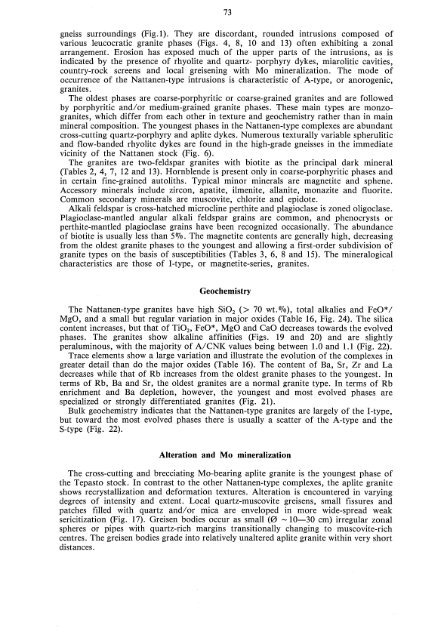nattanen-type - arkisto.gsf.fi - Geologian tutkimuskeskus
nattanen-type - arkisto.gsf.fi - Geologian tutkimuskeskus
nattanen-type - arkisto.gsf.fi - Geologian tutkimuskeskus
You also want an ePaper? Increase the reach of your titles
YUMPU automatically turns print PDFs into web optimized ePapers that Google loves.
gneiss surroundings (Fig.1). They are discordant, rounded intrusions composed of<br />
various leucocratic granite phases (Figs. 4, 8, 10 and 13) often exhibiting a zonal<br />
arrangement. Erosion has exposed much of the upper parts of the intrusions, as is<br />
indicated by the presence of rhyolite and quartz- porphyry dykes, miarolitic cavities,<br />
country-rock screens and local greisening with MO mineralization. The mode of<br />
occurrence of the Nattanen-<strong>type</strong> intrusions is characteristic of A-<strong>type</strong>, or anorogenic,<br />
granites.<br />
The oldest phases are coarse-porphyritic or coarse-grained granites and are followed<br />
by porphyritic and/or medium-grained granite phases. These main <strong>type</strong>s are monzo-<br />
granites, which differ from each other in texture and geochemistry rather than in main<br />
mineral composition. The youngest phases in the Nattanen-<strong>type</strong> complexes are abundant<br />
cross-cutting quartz-porphyry and aplite dykes. Numerous texturally variable spherulitic<br />
and flow-banded rhyolite dykes are found in the high-grade gneisses in the immediate<br />
vicinity of the Nattanen stock (Fig. 6).<br />
The granites are two-feldspar granites with biotite as the principal dark mineral<br />
(Tables 2, 4, 7, 12 and 13). Hornblende is present only in coarse-porphyritic phases and<br />
in certain <strong>fi</strong>ne-grained autoliths. Typical minor minerals are magnetite and sphene.<br />
Accessory minerals include zircon, apatite, ilmenite, allanite, monazite and fluorite.<br />
Common secondary minerals are muscovite, chlorite and epidote.<br />
Alkali feldspar is cross-hatched microcline perthite and plagioclase is zoned oligoclase.<br />
Plagioclase-mantled angular alkali feldspar grains are common, and phenocrysts or<br />
perthite-mantled plagioclase grains have been recognized occasionally. The abundance<br />
of biotite is usually less than 5%. The magnetite contents are generally high, decreasing<br />
from the oldest granite phases to the youngest and allowing a <strong>fi</strong>rst-order subdivision of<br />
granite <strong>type</strong>s on the basis of susceptibilities (Tables 3, 6, 8 and 15). The mineralogical<br />
characteristics are those of I-<strong>type</strong>, or magnetite-series, granites.<br />
Geochemistry<br />
The Nattanen-<strong>type</strong> granites have high SiO, (> 70 wt.%), total alkalies and FeO*/<br />
MgO, and a small but regular variation in major oxides (Table 16, Fig. 24). The silica<br />
content increases, but that of TiO,, FeO*, MgO and CaO decreases towards the evolved<br />
phases. The granites show alkaline af<strong>fi</strong>nities (Figs. 19 and 20) and are slightly<br />
peraluminous, with the majority of A/CNK values being between 1.0 and 1.1 (Fig. 22).<br />
Trace elements show a large variation and illustrate the evolution of the complexes in<br />
greater detail than do the major oxides (Table 16). The content of Ba, Sr, Zr and La<br />
decreases while that of Rb increases from the oldest granite phases to the youngest. In<br />
terms of Rb, Ba and Sr, the oldest granites are a normal granite <strong>type</strong>. In terms of Rb<br />
enrichment and Ba depletion, however, the youngest and most evolved phases are<br />
specialized or strongly differentiated granites (Fig. 21).<br />
Bulk geochemistry indicates that the Nattanen-<strong>type</strong> granites are largely of the I-<strong>type</strong>,<br />
but toward the most evolved phases there is usually a scatter of the A-<strong>type</strong> and the<br />
S-<strong>type</strong> (Fig. 22).<br />
Alteration and MO mineralization<br />
The cross-cutting and brecciating MO-bearing aplite granite is the youngest phase of<br />
the Tepasto stock. In contrast to the other Nattanen-<strong>type</strong> complexes, the aplite granite<br />
shows recrystallization and deformation textures. Alteration is encountered in varying<br />
degrees of intensity and extent. Local quartz-muscovite greisens, small <strong>fi</strong>ssures and<br />
patches <strong>fi</strong>lled with quartz and/or mica are enveloped in more wide-spread weak<br />
sericitization (Fig. 17). Greisen bodies occur as small (0 - 10-30 cm) irregular zonal<br />
spheres or pipes with quartz-rich margins transitionally changing to muscovite-rich<br />
centres. The greisen bodies grade into relatively unaltered aplite granite within very short<br />
distances.

















